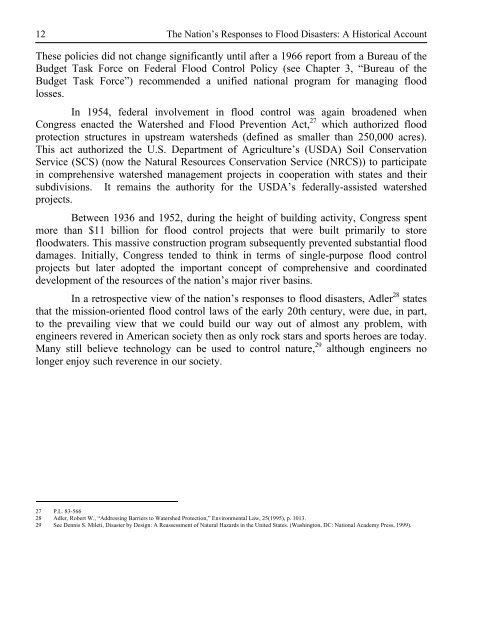The Nation's Responses To Flood Disasters: A Historical Account
The Nation's Responses To Flood Disasters: A Historical Account
The Nation's Responses To Flood Disasters: A Historical Account
Create successful ePaper yourself
Turn your PDF publications into a flip-book with our unique Google optimized e-Paper software.
12<br />
<strong>The</strong> Nation’s <strong>Responses</strong> to <strong>Flood</strong> <strong>Disasters</strong>: A <strong>Historical</strong> <strong>Account</strong><br />
<strong>The</strong>se policies did not change significantly until after a 1966 report from a Bureau of the<br />
Budget Task Force on Federal <strong>Flood</strong> Control Policy (see Chapter 3, “Bureau of the<br />
Budget Task Force”) recommended a unified national program for managing flood<br />
losses.<br />
In 1954, federal involvement in flood control was again broadened when<br />
Congress enacted the Watershed and <strong>Flood</strong> Prevention Act, 27 which authorized flood<br />
protection structures in upstream watersheds (defined as smaller than 250,000 acres).<br />
This act authorized the U.S. Department of Agriculture’s (USDA) Soil Conservation<br />
Service (SCS) (now the Natural Resources Conservation Service (NRCS)) to participate<br />
in comprehensive watershed management projects in cooperation with states and their<br />
subdivisions. It remains the authority for the USDA’s federally-assisted watershed<br />
projects.<br />
Between 1936 and 1952, during the height of building activity, Congress spent<br />
more than $11 billion for flood control projects that were built primarily to store<br />
floodwaters. This massive construction program subsequently prevented substantial flood<br />
damages. Initially, Congress tended to think in terms of single-purpose flood control<br />
projects but later adopted the important concept of comprehensive and coordinated<br />
development of the resources of the nation’s major river basins.<br />
In a retrospective view of the nation’s responses to flood disasters, Adler 28 states<br />
that the mission-oriented flood control laws of the early 20th century, were due, in part,<br />
to the prevailing view that we could build our way out of almost any problem, with<br />
engineers revered in American society then as only rock stars and sports heroes are today.<br />
Many still believe technology can be used to control nature, 29 although engineers no<br />
longer enjoy such reverence in our society.<br />
27 P.L. 83-566<br />
28 Adler, Robert W., “Addressing Barriers to Watershed Protection,” Environmental Law, 25(1995), p. 1013.<br />
29 See Dennis S. Mileti, Disaster by Design: A Reassessment of Natural Hazards in the United States. (Washington, DC: National Academy Press, 1999).
















